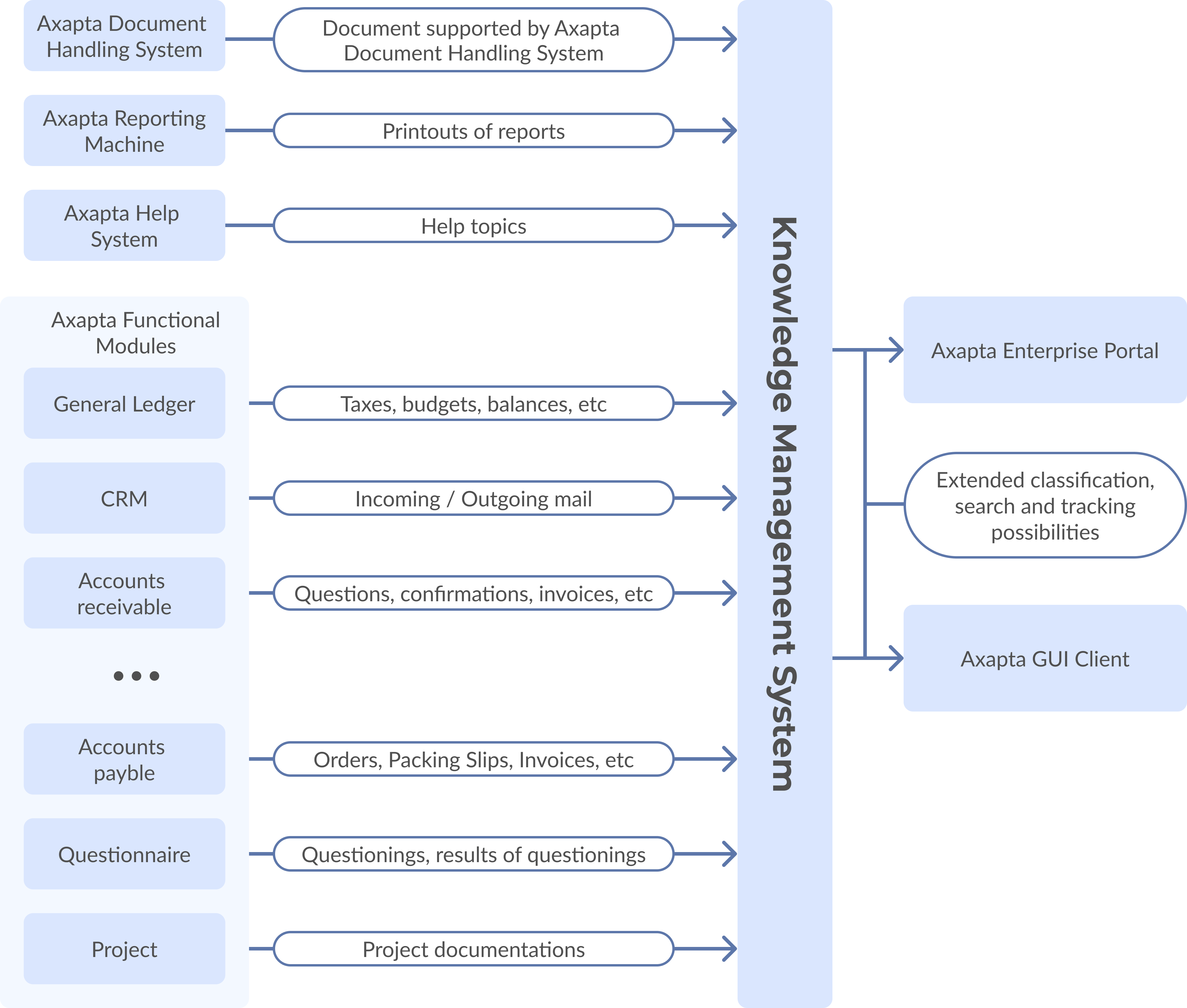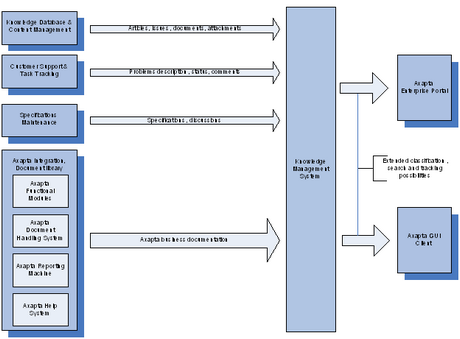Knowledge Database
Application Area
Success of the company among with other reasons depends on the efficiency to reuse its own experience and knowledge. Combination of knowledge databases and content management system can fulfill the tasks of creation, administration, sharing, and presentation of information both for the company itself and for its customers. Perfect organization of the knowledge, worldwide accessibility via Internet, easy administration, and convenient standardized presentation appearance are the main features of such a system.
From the point of view of enterprise management the term "knowledge management" is management of staff knowledge to achieve goals of production and realization of certain goods and services. Such knowledge is usually called corporative, and its management - management of corporative knowledge.
The value of corporative knowledge is huge because the financial, technical and technological condition of enterprise directly depends on the knowledge, skills and habits of the staff. We can say that staff knowledge determines competitive capability of the enterprise. That's why creation and supporting of corporative knowledge is necessary condition of any enterprise.
Therefore, our purpose is to develop Dynamics AX (Axapta) module “Knowledge Management System”, which fulfills these efficiency requirements of knowledge database.
Integration with Standard Modules & Document Handling
Main functional parts of the module are designed to be applicable to any company:
- Knowledge management system represents solution, integrated into all modules of Dynamics AX (Axapta), providing administration support over the documents, created by these modules.
- Structuring and systematization of the documents classically created and maintained within Dynamics AX (Axapta).
- Web publishing of these documents and advanced search capabilities.
- Created and defined by user search categories that can be used for quick filtering and determining of the document source. This can be considered as the analogy to Dynamics AX (Axapta) dimensions, but without limitation in its number.
Dynamics AX (Axapta) Document Handling integration
The integration allows using standard Dynamics AX (Axapta) documents handling system and extends it with the possibility to convert all documents into the Knowledge management system with predefined or selected categories. The function makes it possible to use all advantages of the system applied to documents from document handling.
Integration into Dynamics AX (Axapta) Reporting Engine
Integration into Dynamics AX (Axapta) Reporting Engine means that all reports, created within Dynamics AX (Axapta) can be optionally stored in the structures of the Knowledge management system in predefined format and with selected category. The advantage of the solution is in flexible access to the documents via Knowledge system with the help of KMS Search Engine over the Dynamics AX (Axapta) Enterprise Portal. Sales confirmation, Production order, Purchase invoice, Ledger balance are only example of the reports that can be managed by KMS.
Dynamics AX (Axapta) Help System integration
Dynamics AX (Axapta) Help System is very powerful tool, providing user with the possibility to create help topics for almost every functional element in the system. KMS is intended to make this tool even more powerful, suggesting the possibility of additional saving of link to help topics into its own structure. This adds to the help topics all the flexibility of Knowledge management system.
Dynamics AX (Axapta) Basic Modules integration
Integration into basic Dynamics AX (Axapta) modules means optional storage of the selected information from Dynamics AX (Axapta) forms and tables in KMS with the subsequent publication of it in Enterprise portal.
Place of the Knowledge Management System in Dynamics AX (Axapta) is presented at Figure 1.

Figure 1. Knowledge Management System and Dynamics AX (Axapta) Integration
Knowledge Database & Content Management
Dynamics AX (Axapta) module that implements all basic functions of knowledge database and content management system, based on the architecture, provided by Dynamics AX (Axapta), including Dynamics AX (Axapta) web portal, security and user roles administration, database connectivity as well as Dynamics AX (Axapta) development environment. It significantly extends already existing in Dynamics AX (Axapta) Enterprise Portal Content Management solution. All details of the module are described later in this document. As other Knowledge Database, the system allows storage and maintenance of articles and attached documents in any format, supported by MS Windows. The most important documents are ones of MS Office, Adobe PDF, images, multimedia files etc. Links, cross-references, search keys – are the other advantages of the whole system.
Customer Support & Task Tracking
Customer support functionality is customer-oriented “problems & solutions” web-portal with flexible notification / approval system per e-mail or SMS. This provides prompt support for the customer without phone calls and with all history of negotiations on the topic. It tracks implementation of assigned tasks, providing actual status any time.
Specifications Maintenance
Maintenance of specifications is the next useful application of the system. It makes it possible to control the whole process from specification prototype, through its discussions via discussion boards, modifications with version control and approval system. The complete process can be controlled both via Web Enterprise portal and using Dynamics AX (Axapta) client.
Every mentioned application incorporates all features and therefore has all the advantages of the Knowledge Management System. Among them – accessibility via both Enterprise Portal and Dynamics AX (Axapta) GUI Client, classification, advantage search possibilities, discussions, subscriptions, versioning, approval mechanism, user roles and permissions. More detailed requirements, presented as the set of features are described later in this document. General organization of KMS module is presented at Figure 2.

Figure 2. Knowledge Management System in Dynamics AX (Axapta)
Features – Knowledge Maintenance
- Fully customizable classification for articles and documents within Dynamics AX (Axapta).
- Assigning of standard Dynamics AX (Axapta) notes, documents and articles to elements of classification structure.
- Navigation through the documents using classification tree – easy access to the documents that belonging to neighboring groups.
- Publishing of the documents and articles on the web – access to structured information via both Dynamics AX (Axapta) interface and web portal.
- Creating of the articles online via web portal.
- Document attachments of any type: MS-Office documents, multimedia files, images, PDF, HTML, etc.
- Two interfaces supported: Web Portal and Dynamics AX (Axapta) GUI.
- E-mail integration: possibility to send selected articles and documents to system users and customers by e-mail.
- Printing integration: possibility to print articles with printout friendly layout.
- Notification system: any manipulations with articles and documents are logged and notifications are sent to responsible persons.
- Approval system: articles and documents can be approved by responsible persons on any stage – creation, review, modification, publication, etc.
- Discussion boards: forum-like organized possibility to discuss articles, documents, etc.
Features – Knowledge Maintenance Advanced
- Click statistics, annotations and rating possibilities.
- Subscription mechanism.
- Reminder mechanism.
- Expiration mechanism for time sensitive articles.
- Version control: control over all user modifications in articles, and possibility to restore previous versions of articles.
- Check-in / check-out: resolving of simultaneous access to a single resource (article, topic, discussion post, attachment etc.) by several users.
- Priority assignment: for specification control this helps to process articles and documents in desired order.
- Article templates: possibility to represent articles with predefined and assigned layout of the document.
- Archives.
Features – Search Engine
- Full-text search capabilities in documents of standard types and own articles.
- Keyword search: keywords, article ID, proximity search (“see also”).
- Search in definite parts of articles, such as article itself, abstract, summary, keywords, discussion board, etc.
- Filters: fast filtering using indexed pre-selected categories.
- Cross-references & direct links.
- Category search: search infinite number of categories and subcategories, intuitive navigation using category tree, selective search in definite categories and up to specified depth level.
- Recent articles and Favorites: placing of recently used articles on the top of the category, marking of most useful articles as favorites.
Features – Search Engine Advanced
- Advanced keyword search: stemming, wildcard keywords search.
- Multi-language search: search text including national characters of various languages.
- Natural language search.
- Assignment and search articles via user specific keywords and notes.
- Remote website search: indexing and search additional websites.
- FAQ – frequently asked questions with articles, generating of top frequently asked questions.
Features – Customer Portals
- Customer & Employee portals: web accessible portals for customers, employees and public access.
- User group roles and access rights: mechanism to open or limit access rights for groups of users based on their roles.
- Registration mechanism: provides link between registered online user and user in the system, assigns user groups, roles and, therefore, permissions.
- Security mechanism: additional access rights control using user registration info and/or location information, e.g. IP address.
- Snap-In mechanism: possibility to organize private HTML portal, based on the current results of search in main portal, independent portal can work as standalone information base without any connection to original system.
Features – Content Management
- News.
- Events.
- Announcements & notifications.
- Contacts.
- Thematic forums.
- Private messages.
- Message boards.
Administration
- Synchronisation of KDB database information and disk storage. Automatic synchronisation for KDB manipulations. Possibly manual synchronisation during some merge or replication jobs.
- Replication. Compare for interfering elements. Marking of elements from another database during import. History storage for interfering elements. Approval or acceptance for marked elements in local database. Replication of hierarchical classifier, articles, discussions, attachments, parameters, user specific settings.
- Topics, issues, articles exchange as a single replication case. Export in hierarchically structured format.
- Windows Active Directory integration. Network and other permissions for documents access over the network. Synchronization with Dynamics AX (Axapta) Web roles and Application user permissions.
- Structure-to-Structure import. Correspondence between nodes of some frequently used external structure / KDB / DB / web site and the system for easy replication.
- Import of structured folders on disk into clean KDB database. Import of articles from external system.
- Periodical indexing. Analysing and structuring of keywords and description sections for fast search support.
- System configuration possibilities: single or multiple database, with or without replication, with or without Version control (only simple version control on import for replication), with or without domains (only single hierarchical classifier).
Statistical Reporting
- Participation statistics: visitors, employee access.
- Cross-statistics for projects, modules, employees, etc. E.g. to find the most posting person on selected subject.
- Article statistics: search, uploads, manipulations, etc.
- Rating statistics.
- Frequently asked questions statistics.
Compatibility
- Articles export format support. Articles can be presented in the form of HTML, Microsoft Word, Microsoft Excel, Adobe PDF, and Plain Text.
- Document attachments. Any type of documents can be integrated as attachment to the system. This includes Microsoft Office documents, image documents, all media files, archives, Adobe PDF, etc.
- Active Directory integration for user authentication and user management.
- Windows integration. Windows GUI interface, Internet Explorer, context menu, etc.